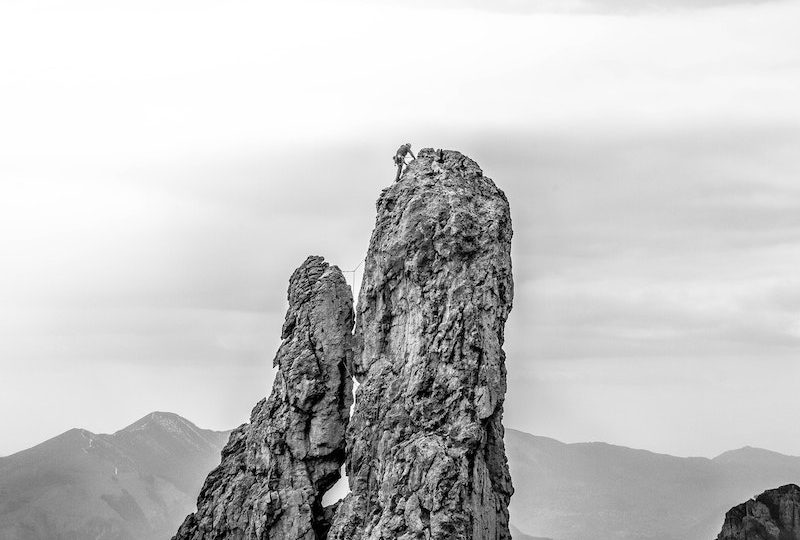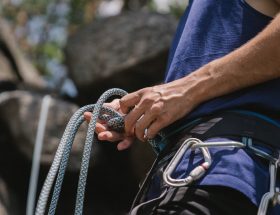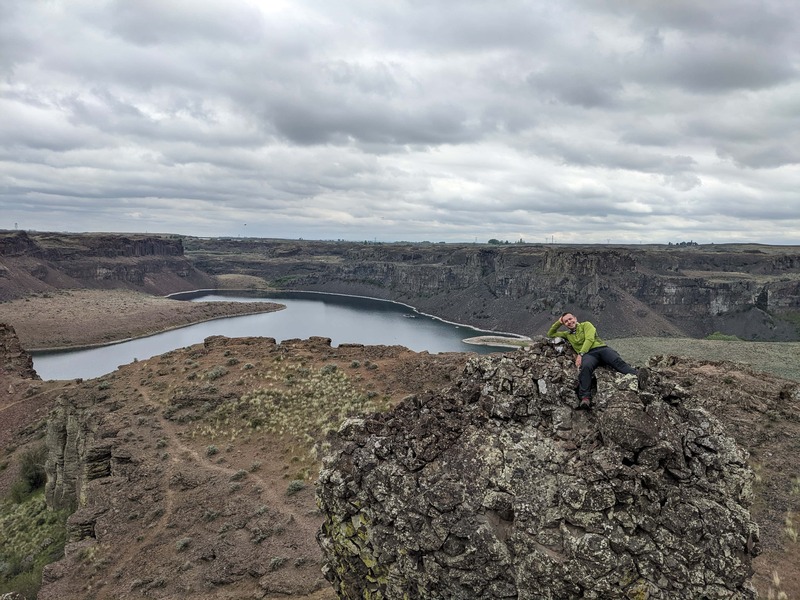
Climbing can be an exhilarating experience, but it is also a skill that requires discipline, patience, and practice. If you’re looking to refine your climbing technique and ascend to greater heights, then this guide is for you. Here you will find all the essential tips on how to achieve success in climbing – from mastering proper footwork and body positioning to building strength and endurance. Read on to discover the secrets of improving your climbing technique and take your skills to the next level!
Establishing Proper Footwork
Establishing proper footwork is one of the most important elements for successful climbing. Having a good understanding of where your feet should go and how to place them correctly will increase confidence and help you to climb with more ease and control. It is essential to be aware of how your weight is distributed on your feet when climbing, as this can help you maintain balance and reduce fatigue.
To establish proper footwork when climbing, it is important to first understand where your feet should go. This includes finding footholds that are comfortable and secure, as well as making sure your toes are pointing in the right direction to provide maximum support. Additionally, it is important to be conscious of how your body weight is distributed between both feet when using footholds. Having an even distribution of weight on each foot will help you maintain balance and reduce fatigue while climbing.
Furthermore, proper foot placement can help you move up the wall more efficiently. To ensure this, it is important to think ahead before making any moves and plan out which footholds and handholds you will use. This way, you can visualize where you want to go and what kind of footholds will provide the best support for each step before committing to a move. Additionally, it’s beneficial to practice moving quickly between footholds while still being mindful of where you’re placing your feet. Doing so will help develop agility and coordination skills that can help save energy over larger climbs.
Finally, take time to practice and refine your technique by experimenting with different foot placements on a variety of terrain types. This will help improve your skillset and build confidence in challenging situations. With enough practice, you should start to notice a difference in the speed and precision with which you climb. Establishing proper footwork is a key component of becoming a skilled climber, and taking time to hone these skills will pay off in the long run.
Understanding Body Positioning
When it comes to climbing technique, body positioning is an essential factor for success. By having the proper body position, climbers can ensure that their energy and power are used most efficiently. The optimal angle for each move will vary, but generally a more vertical stance should be taken – with the feet pointing directly at the wall and the hips as close to the surface as possible. This stance maximizes leverage and power, resulting in smoother climbing.
In order to pull off this body positioning successfully, certain muscles must be strengthened and built up for support. Core muscles are especially important for body positioning, as they help maintain balance and stability across a route. Besides your core, biceps, triceps, forearms, back, and leg muscles also need to be developed in order to be able to handle the strain of climbing.
Furthermore, harnessing momentum is critical when understanding proper body positioning while climbing. Climbing requires you to move quickly and confidently from one hold to another, which means you have to be aware not just of how your body moves through space but also how it transfers power from one handhold or foothold to the next. Momentum must be controlled in order for this action to take place; otherwise, climbers risk tire out quickly due to inefficient movement and use of energy.
To sum up, proper body positioning is essential in climbing. Not only does it allow climbers to use their energy and power most efficiently, but it also helps increase balance and stability on the wall. In addition to understanding the correct angle for each move, climbers must also strengthen specific muscles that bear their weight while maneuvering up a route. Furthermore, harnessing momentum is key in order reduce energy consumption while making efficient climbs.
Developing Grip Strength
Developing proper grip strength is essential for successful climbing, as it allows you to stay on a wall longer and move more efficiently. For this reason, it is important to use a variety of exercises that specifically target different muscle groups in your hands and forearms. Weighted and bodyweight exercises such as pull-ups, hangs, rows, dead hangs, curls, push-ups, and flexor exercises can help to improve contact strength and power. Additionally, incorporating pinch blocks, finger boards, and other dedicated tools into your training regimen can help to enhance finger strength.
Hangboards are also an excellent tool for climbers wishing to improve their grip strength. They provide the opportunity to practice all types of handholds – from reaching far away holds to grabbing small edges – which is essential for increasing contact strength. Additionally, hangboarding can help climbers develop overall hold endurance for long routes or bouldering problems.
However, it is important to maintain proper form when doing any grip-related exercises in order to reduce the risk of injury. Over-training is also something to be aware of – especially when first starting out – as this can lead to strain or even tears in tendons and ligaments if done incorrectly or without adequate warm-up time prior to each session. Therefore, taking regular breaks throughout training sessions is essential for preventing fatigue-related injuries as well. With the right combination of exercise selection and proper form, climbers can increase their grip strength quickly in a safe manner.
Power vs Finesse
Power and finesse are two important elements of good climbing technique. While power is useful for quickly scaling up steep inclines or challenging walls, finesse is necessary for safely navigating tricky terrain without wasting energy or risking injury. To become a better climber, it’s essential to learn how to balance these two elements in order to make steady progress without compromising safety.
When it comes to power, it should only be used when needed — for example, during a race or competition. When deploying power, the climber should grip firmly on holds with their hands and feet, pushing off from footholds with strong leg muscles, and leveraging their body weight up the wall. However, it is also important to use caution as too much power can lead to fatigue that could cause mistakes and falls due to exhaustion or lack of focus.
On the other hand, finesse should be used when climbing technical terrain that requires careful movement and precise foot placements in order to traverse safely and efficiently across a wall or up a rock face. Here one needs to rely less on raw power and more on agility and gracefulness while paying close attention to each hold so they can plan ahead without rushing or hesitating too much. This kind of climbing requires superior balance and control rather than brute force but can be very rewarding once mastered.
Ultimately, developing proper power vs finesse technique is critical for any climber looking to improve their performance and progress steadily in the sport. Knowing when each technique should be utilized will help you climb faster, safer, better—and ultimately higher! Knowing when and how to use power as well as finesse allows you to complete climbs safely while conserving energy and avoiding the unnecessary risk of injury. With this knowledge in your arsenal, you’ll be sure to reach greater heights in your climbing career!
Increasing Endurance and Stamina
Increasing endurance and stamina is critical when it comes to successful climbing. Training your body for climbing is one of the best ways to increase endurance and stamina; this means doing specific activities that are designed to build muscle strength, cardio fitness, and overall physical preparedness within the context of a climbing or bouldering environment. Interval training is an effective workout designed to help you develop a stronger climbing base; short bursts of high-intensity exercises such as pull-ups, burpees, squat jumps, and planks followed by rest periods can be a great way to build good climbing habits while developing key muscles needed for climbing.
In addition to physical training, exercise variety is also important in developing overall fitness. For example, utilizing a variety of exercises such as core and grip strengthening can also help improve endurance; not only does it work multiple muscles at once, but it helps to improve balance for more coordinated movements on the wall. Other beneficial exercises include dynamic stretching (which helps with flexibility) and bodyweight exercises (which can help increase overall strength). Furthermore, diet plays an important role in helping climbers sustain energy levels throughout their climbs; try incorporating nutrient-dense meals with complex carbohydrates and lean proteins before each climb to ensure proper fuel levels for each session. Finally, stretching before and after your climbs can help reduce fatigue and soreness, resulting in increased endurance and stamina; this will not only improve performance but also aid in preventing unwanted aches or injuries that can potentially occur during a climb.
By incorporating these strategies into your practice routine you will see marked improvements in your overall measures of endurance and stamina when climbing; just remember that practice makes perfect, so don’t forget to take rest days between training sessions as part of your preparation! Additionally, make sure you are tracking your progress from session to session so you can identify areas that may need extra attention or improvement. With a strong focus on physical training, exercise variety, diet, stretching, and adequate rest days, you’re well on your way towards increased endurance and stamina when climbing.
Reducing Injury Risk
When it comes to climbing, reducing injury risk is of utmost importance. Developing a strong core and improving flexibility are two key components of reducing injury risk while climbing. Strengthening your core will enable your body to better support itself through challenging climbing movements, and stretching can help to improve flexibility and reduce the risk of an injury due to overextension or muscle strain.
Moreover, recognizing one’s physical limits is essential for avoiding injuries while climbing. Knowing when to stop before becoming too fatigued or exhausted can ensure that a climber does not push too hard and puts themselves at risk of an injury. In addition, listening to one’s body and being aware of any pain or discomfort that arises can help protect against overexertion during a climb.
Finally, proper use of safety gear and techniques such as dynamic movement and momentum can also help reduce the risk of sustaining an injury while climbing. Utilizing safety gear like ropes and belays can provide support as you climb, creating a secure environment in which to practice. Additionally, using techniques like dynamic movement and momentum can reduce the need for excessively long holds or awkward positions at difficult sections along the route, thus minimizing the risk of an injury.
Overall, by developing a strong core, improving flexibility, recognizing physical limits and utilizing proper safety gear, climbers can significantly reduce their risk of sustaining an injury while climbing. Paying attention to detail in each of these areas will help keep climbers safe and ensure they have a safe and enjoyable climbing experience.
Practicing Technique for Progress
Practicing technique is essential for making steady progress while climbing. However, it is important to do so in the right way; otherwise, you may not see meaningful improvement. Incorporating specific drills into your practice can help you to observe and refine your technique. This could be as simple as doing a pre-climb warmup of specific movements, or repeating certain moves many times to ingrain them in your muscle memory. Additionally, making a plan of the areas you want to focus on – such as footwork, balance and grip strength – will help you stay on track with your progress.
It’s also important to set achievable goals and monitor your progress. This could include focusing on one certain climb or problem at a time, setting yourself a personal best record or aiming to try harder routes. Regularly assessing your progress will give you insight into how far you have come since the start of your practice and keep you motivated throughout this journey.
Finally, practicing with partners can be beneficial in keeping each other motivated and accountable. Whether it’s sharing tips and advice, spotting each other while climbing, or simply encouraging each other when things get hard, having companions with similar interests can make all the difference in achieving progress in technique.
Overall, improving your climbing technique is essential to becoming a better climber. It involves focusing on footwork, body positioning, grip strength, and finding the right balance between power and finesse. Additionally, it’s important to increase your endurance and stamina and reduce the risk of injury. Finally, make sure to practice your technique regularly to ensure steady progress. With these strategies in place, you’ll be able to take your climbing to the next level.









